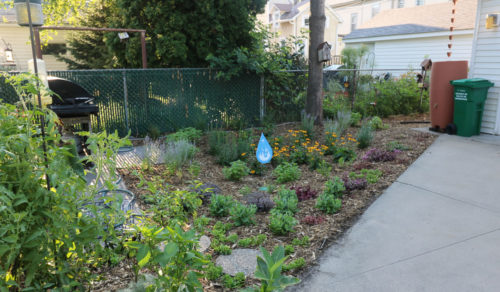Raingardens

Raingardens are depressed (bowl-shaped) gardens with sandy soils and deep-rooted native plants. They act like natural filters, capturing stormwater runoff and letting it soak into the ground, where the soils trap and remove harmful pollutants. In addition to managing stormwater, raingardens provide beneficial habitat for pollinators and other wildlife.
Raingardens are an attractive and increasingly popular option for managing stormwater runoff in a sustainable, eco-friendly way. They are relatively easy to install and may require less maintenance that other types of landscaping. Their deep-rooted plants absorb more water than other plant types, which means they can go for longer periods of time without watering.
In spite of their name, raingardens are not usually filled with water. They’re usually designed in such a way that all the water should soak into the ground within 48 hours after it rains, so most of the time they are dry.
Variations
Biofiltration basins are nearly identical to raingardens, except for one key difference. Instead of allowing stormwater to soak into the ground, biofiltration basins filter pollutants out of stormwater and then allow it to drain through an underground drainpipe and into the stormsewer. This is a useful option in areas where clay soils make it hard for water to infiltrate the ground, or where the soils are contaminated.
Bioswales are shallow channels designed to capture and infiltrate runoff from a specified area. Like raingardens, they are filled with vegetation and sand soils that help stormwater soak into the ground. The main difference is in the design: Bioswales are typically longer, narrower and deeper than raingardens, and are frequently used next to roads or other impervious surfaces.
How to Build a Raingarden
Building a raingarden is a relatively straightforward process, and there are many videos and how-to guides available online. We’ve compiled a list of some of the best guides, along with a video playlist (below) that should help you get started on your own raingarden project.
Guides and Resources
Raingarden Maintenance — MWMO Blog Post
Raingardens (Fact Sheet) – MWMO
Raingardens: A how-to manual for homeowners (PDF) — Wisconsin Department of Natural Resources
Urban Gardener’s Guide — Metro Blooms
Blue Thumb: Planting for Clean Water — blue-thumb.org
Infiltration Test — Philadelphia Water
Videos
Enjoy our DIY raingarden video playlist, also available on our YouTube channel.
*Note: The MWMO does not endorse specific products or companies. All videos are selected for their educational value only.